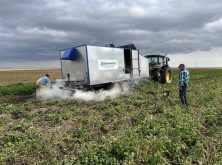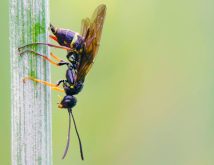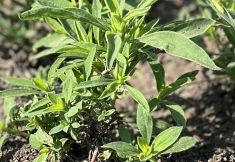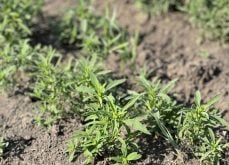We spend more money trying to manage wild oat in Western Canada than any other weed, says Dr. Neil Harker, a weed ecology and crop management scientist with Agriculture and Agri-Food Canada. “It’s a driver weed.” Here’s a bit of a refresher on wild oat, what’s new with research, and what you need to know about managing this weed today.
Wild oat is similar to wheat, says Harker, and that’s part of the reason that it is so prevalent on the Prairies. The other reason is that it is a summer annual weed, “and growers now almost exclusively grow summer annual crops: wheat, canola, lentils, peas.”
Read Also

Claas brings 1000 Series SP forage harvesters to Canada
In mid-August, Claas unveiled its new line of Jaguar forage harvesters at an event in Visalia, California, deep in the heart of that state’s dairy region.
Because of this, these crops favour summer annual weeds, like wild oat, wild buckwheat, and green foxtail, says Harker.
The reason wild oat is particularly difficult to control is because some of its seed is dormant in the soil, so “when it sheds its seeds, they can last for quite a few years in the soil.”
Wild oat is prevalent all throughout the Prairies, “there’s really no place that it seems to thrive better than others.” Part of the problem in treating this weed is that much of it has become resistant to herbicides over the years. Like any plant, there are always resistant mutants in the population, and over time those resistant to a frequently-used herbicide take over, says Harker, “because you’re doing the same thing over and over again,” that is, planting the same crops and using the same herbicides.
Interestingly, says Harker, “the really old ways of treating wild oat, before herbicides, were fairly effective at controlling the weed.” This included very diverse crop rotations, growing perennial forages or root crops like potatoes, as well as using the stale seedbed technique, where farmers plant late. In stale seedbeds, wild oat would grow in the spring, farmers would “till them all down, and plant the crops later.” These techniques suppressed wild oat, but did provide the dramatic impact herbicides did, with very little effort, says Harker. Once herbicides became prevalent over the last 40 years, farmers stopping using the old methods and depended almost solely on herbicides. Over time, the mutant plants that were resistant to herbicides before herbicides were even applied, took over. That’s where we are today, and that’s where the problem comes in.
Harker and his colleagues have just published research in the journal Weed Science about how the “most common rotation on the Prairies, which is canola-wheat-canola-wheat,” in a full herbicide regime, compared with more diverse rotations, which included perennial alfalfa, early-cut silage and winter cereals, like fall rye and winter wheat with much less herbicide.” They also used a higher seeding rate in the diverse rotations, says Harker. “We found that you could go three years without using wild oat herbicides, if you used these other techniques (higher seeding rates, early-cut silage, planting winter cereals or alfalfa) and effectively manage wild oat.”
They found that you could manage wild oat in a diverse rotation with much less selection pressure for herbicide resistance as well as you could in a canola-wheat-canola-wheat rotation that included a full herbicide regime. “The catch is people want to grow canola-wheat-canola-wheat, because they don’t think they can make as much money with some of the other crops,” says Harker. “That may be true in some cases in the short term, but in the long term, as resistance becomes more widespread, they will be forced to grow something other than canola and wheat crops over and over again.”
Thinking to the future is part of what needs to happen. Harker says they are encouraging farmers to sacrifice a bit in the short term for those future benefits. But this isn’t all about sacrifice; it is partially about changing mindsets.
Winter wheat, for example, is profitable but farmers don’t grow it very much because it takes them out of their comfortable summer annual crop routine. And winter wheat “is so competitive with wild oat you don’t even need a wild oat herbicide.” So by planting it, “you take a whole year of selection pressure away,” meaning wild oat population resistance to a particular herbicide is delayed. Some farmers even find winter wheat more profitable than spring wheat, says Harker.
Other options include trying alfalfa, “if you can find a market for it. It is a perennial that is cut twice a year, meaning weeds, including those resistant to herbicides, don’t have a chance to go to seed.” The key is finding some options on your farm that allow you to reduce herbicide frequency or avoid herbicide applications some years. Then when herbicides are applied, there will be more susceptible plants in the weed community.
There are other also other tools, says Harker. One is chaff collection (invented in Canada). Most combines spread the most successful weeds (the ones that have escaped your management) all over the field in the chaff fraction.
In Australia, where weed resistance is a much more serious problem, chaff collection, burning chaff windrows and machines likes the Harrington Seed Destructor are becoming more popular; they have few other weed management options left. “We’re not quite there yet, but will be, says Harker, if no changes are made.” You may need to invest in some new equipment or hook-up an old chaff cart to really get involved in weed resistance management.
What’s definitely true is that if things stay status quo on your farm, canola-wheat-canola-wheat will eventually be less profitable. “Many southern U.S. cotton farmers have very few effective herbicide options left; those that are left are much more expensive and reduce profitability. They got there by growing continuous cotton or by rotating to another crop that used the same herbicide. In some parts of the Prairies, we have wild oat that resists all Group 1 and Group 2 herbicides,” says Harker, “and those are the herbicides that farmers depend on in many crops.”















